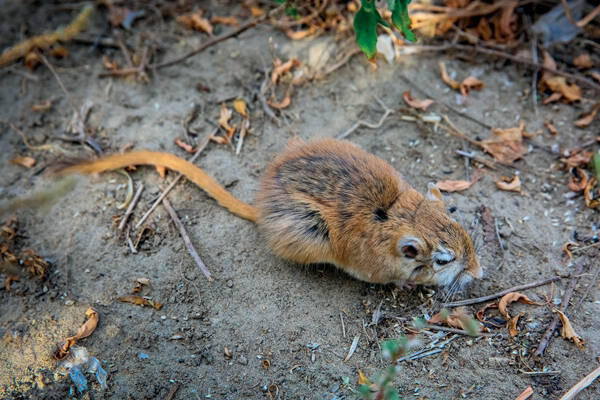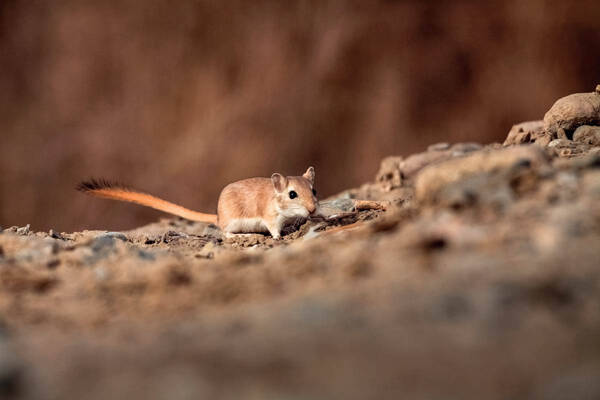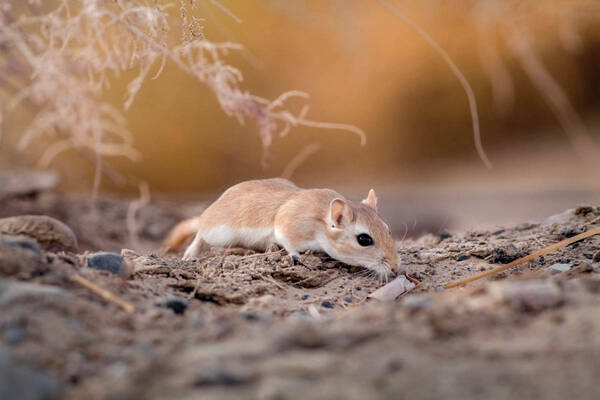Meriones meridianus
IUCN
LCBasic Information
Scientific classification
- name:Meriones meridianus
- Scientific Name:Meriones meridianus,Yellow rat, noon gerbil, midday gerbil
- Outline:Rodents
- Family:Rodentia Cricetidae Gerbil
Vital signs
- length:105-155mm
- Weight:
- lifetime:
Feature
The color of the body hair varies greatly, ranging from sandy yellow to dark brown. The tail hair is brownish yellow above and below, with long black or dark brown hair near the tail tip.
Distribution and Habitat
In China, it is distributed in Xinjiang, Gansu, Qinghai, Shaanxi, Inner Mongolia, Shanxi, Hebei and Ningxia. Abroad, it is distributed in Mongolia, Afghanistan, Iran and the Caucasus region of Russia.
Meriones meridianus mainly inhabits desert or semi-desert areas. Its typical habitat is sand dunes, sand hills and inter-hill lowlands where desert shrubs such as Haloxylon ammodendron, Pseudostellaria oxyphylla, Red Sand, Camel Thorn, White Thorn and Tamarix are grown. In the Tarim Basin, it likes to inhabit riverside Populus euphratica forests and xerophytic reed sand land. Sometimes it is also found in non-zonal sand land and agricultural areas. In Inner Mongolia, the typical habitat of Meriones meridianus is sand dunes and sand land covered with shrubs and semi-shrubs.
Appearance
Individuals are relatively small. The average body length is about 120mm. The tail length is slightly shorter than the body length, and the tail length of some individuals is equal to or slightly longer than the body length, and the tail length ratios of different geographical populations are also slightly different. The distinctive features are: the soles of the feet are hairy, with no exposed area, the back of the body is sandy brown, the base and tip of the hair on the ventral surface are pure white, and sometimes there is a brown stripe in the middle of the abdomen. The top and bottom of the tail are brownish-yellow, with only the end of the tail having long black or gray hairs forming hair bundles. Claws yellowish white.
Details
Merionis meridianus is a gerbil unique to my country, belonging to the Gerbillinae subfamily. The species-level classification status is stable, with many subspecies, 15 in total. At least 7 subspecies have been described in China, but whether they are all valid needs further study. It mainly lives in desert oases. The population is large in the shelterbelts between farmlands in the desert, with dense burrows and active during the day. There are two peak breeding seasons, April and July. The average litter size is 6.

Merionis merguinea pigs are animals of deserts and desert steppes in Central Asia. They live in a wide range of arid environments. They often gather in small areas of suitable living environments. The number of them is extremely high around salt lakes and on sand dunes between farmlands in the desert steppes of Inner Mongolia. In the same habitat, long-clawed gerbils are mostly distributed in field stalks and wastelands between fields, with a relatively uniform density, while Merionis merguinea pigs are distributed in shrubs and sand dunes, with an uneven density. This is the difference in the spatial distribution of grassland and desert rodent populations.
Omnivorous. Mainly feed on stems, leaves and fruits of herbs, xerophytic shrubs and small shrubs. Some thorny shrubs, such as narrow-leaved Caragana and Salan spinulosa, are also eaten by it. In spring, fragments of coleoptera insects were found in its stomach. In agricultural areas, it steals various grain crops, even raisins, watermelons, melons, sunflower seeds and tree seedlings. Merionis seldom drinks water directly, and can only be seen eating leaves with dew in autumn. Under cage conditions, the daily food intake is 18~34g/day. The daily food intake in summer is higher than that in autumn. Cave system

The cave system of Merionis merionarius can be divided into wintering caves, summer caves and complex caves. Female mice often block the cave entrance after entering and exiting the cave during pregnancy and lactation. The population and distribution area are mostly in the desert of the Hexi Corridor, and it is a dominant species. The capture rate of the summer trap method is mostly above 10%, and can reach 40% in some areas. The caves of this species are scattered and do not form dense cave groups. The tunnels are not very complex, and most of them have single or double exits. Summer burrows are 2-3m long, with the nests usually no more than 1m above the ground; winter burrows are longer, up to 4m or more, with the nests about 2m above the ground. In winter, Meriones meridianus gather in winter burrows, with 5-10 individuals living in each burrow, thus forming some scattered and isolated "gathering areas".
The annual population of Meriones meridianus fluctuates slightly. From 1991 to 1998, the annual average capture rate was 1.02%, with the highest being 1.94% in 1994 and the lowest being 0.34% in 1991. The highest year was 5.71 times the lowest year. [6] The density level in the same season of each year is roughly the same. However, the population varies greatly between seasons. The population in autumn is about 5-10 times that in spring. In autumn, young mice account for about 80% of the population. The number of young mice in desert oases, low-lying sandy land and desert shrubs is higher than that in gravel deserts. And these environments are mostly reclaimed as agricultural production bases, so farmland rats in these areas are quite serious.

This species is listed in the 2013 Red List of Endangered Species of the World Conservation Union (IUCN) ver3.1-Least Concern (LC).
It has been included in the "List of Terrestrial Wildlife with Important Economic and Scientific Research Value under State Protection" issued by the State Forestry Administration of China on August 1, 2000.








